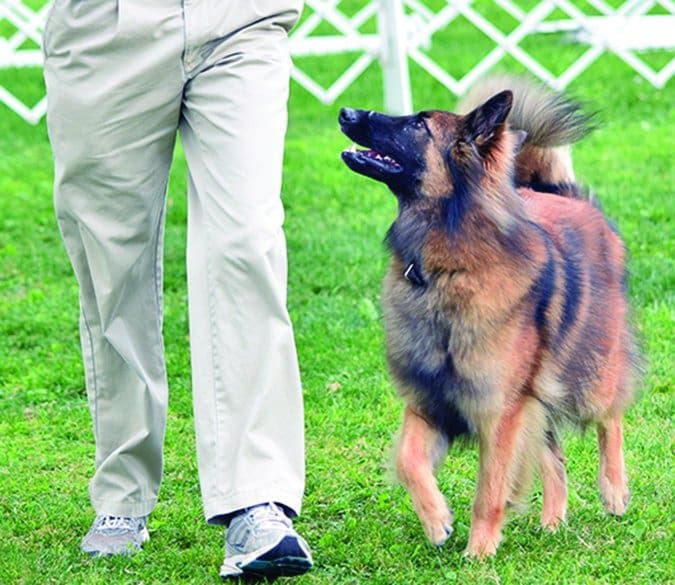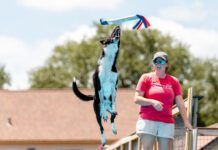There’s a saying that is widely known among certain circles of competitive dog sport enthusiasts: “If judges made house calls, we’d all have obedience trial champions!” The phrase speaks to the challenging nature of getting a competition dog “ring ready” – that is, training to the point where he can perform successfully not just at home or at the local training center but also in unfamiliar, distracting locations common to dog show environments. The expression has been made a little less relevant, though, by the advent of “video titles.” Many dog sports enthusiasts have embraced technology and its ability to offer a variety of remote performance options, allowing dog and handler teams to demonstrate performance skills via video submissions rather than in-person at a dog show.
Nicole Vaughn
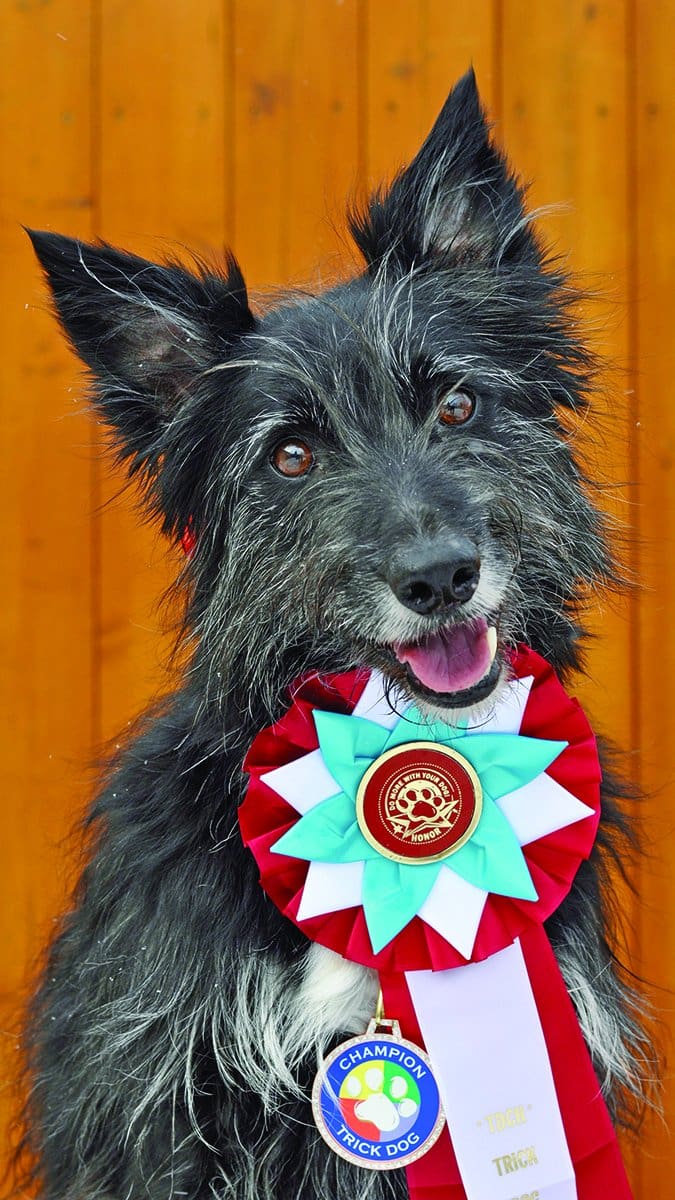
Today, dog-and-handler teams can earn video-based titles in rally obedience, freestyle, obedience, tricks, assorted training skills, and parkour.
Similar to participation requirements for traditional, in-person organizations, most video-based titling groups require handlers to register their dogs for a fee, plus pay an entry fee ($20 to $30) for each video entry to be judged. Some titles require multiple qualifying runs, while others can be earned after successfully demonstrating mastery of skills at a certain level.
Video-based performance opportunities offer a variety of benefits. They are ideal for dogs (and their handlers!) who enjoy training, but for whom demonstrating their knowledge in unfamiliar settings is difficult.
For some dogs, becoming “ring ready” is about learning to ignore myriad distractions in favor of the performance task at hand. For other dogs, the biggest challenge to ring readiness is tolerating unfamiliar people, places, and other dogs – working through emotional issues such as fear or aggression. Often, despite a handler’s best efforts, such dogs fail to progress to the point where they can comfortably (or, in some cases, safely) perform in a traditional dog show environment. In the past, these dogs would often be “washed out” by handlers. Dog-sports organizations that allow “video titles” enable these dogs and owners to continue working toward specific achievements.
Fan and Founder
“For me, it all started with my reactive dog,” says Jude Azaren of Willingboro, New Jersey, who founded Cyber Rally-O, one of the first video-based titling organizations, in 2011. “He was an adopted foster who was initially so sweet, but became aggressive.”
Rally obedience (often called Rally-O) competitions are similar to regular obedience, but instead of waiting for a judge to tell the competing team what to do, the handler directs her dog around a “course” that consists of 10 to 20 signs, each describing a specific behavior.
The signs typically include simple behaviors such as a sit/down/sit sequence, and heeling behaviors that require challenging food refusals, backward heeling, and assorted obedience “finishes,” which require the dog to move swiftly into heel position. Cyber Rally-O adds challenges not often seen in other venues, such as figure-eight jumps, sending the dog to jumps from a distance, and sequencing multiple jumps with retrieving.
So far, the organization has awarded an estimated 300 titles over five levels in two rally divisions, and recently added a separate dance division.
Dog Sport Organizations That Offer Video Titles
| AGILITY | Virtual Agility League |
| ASSORTED TRAINING SKILLS | Wag-It Games |
| FREESTYLE | Cyber Rally-O (despite its name, offers titles in freestyle too!) |
| Dogs Can Dance | |
| Musical Dog Sport Association | |
| Rally Freestyle Elements (offers titles in freestyle AND a rally/freestyle combination sport) | |
| World Canine Freestyle Organization | |
| OBEDIENCE | Non-Competitive Obedience Association |
| Fenzi Training Excellence Assessment Modules (TEAM) Note: Currently in development. Emphasis on excellence in training versus finished behavior chains. | |
| PARKOUR | International Dog Parkour Association |
| PRACTICAL TRAINING SKILLS | Dog Scouts of America |
| RALLY OBEDIENCE | Cyber Rally-O |
| TREIBBALL | American Treibball Association |
| TRICKS | Do More with Your Dog |
Rules Vary
Like any organization sanctioning in-person events, each video-based organization sets its own rules. For example, Cyber Rally-O teams are allowed to use food rewards during a run, but only when the team is stationary, after completing one task and before moving to the next task. Visible food is not allowed; food must be hidden in the handler’s pocket until it can be given at the appropriate time, such as between exercises. If a handler feels safer using a long-line during a distance exercise, that’s fine, too.
While performance “traditionalists” might scoff at the idea of using food during a run, or at the need for a leash as a “safety net” for fearful and/or reactive dogs, Azaren says allowing the judicious use of such training tools is all about accessibility.
“What’s the difference?” asks Azaren. “If the dogs can do the behaviors, why shouldn’t they participate? They aren’t competing against each other, they’re competing against a standard, so let’s make it accessible for people.”
In the spirit of accessibility, Cyber Rally-O does not have required jump heights for elements requiring jumping. Handlers are free to set jumps as low as is needed for a dog to safely and comfortably execute the obstacle. If that means the dog can’t technically jump (such as participants using mobility carts), that’s fine, too; handlers can simply guide the dog through the jump uprights.
Nicole Vaughn

0)]
Increasing Access
For many people who live in remote areas, traditional dog shows are inaccessible for practical reasons. Exhibitors often must travel long distances to attend in-person performance events, complete with overnight hotel stays, dining out, gas, and the occasional need for a pet sitter to check on other animals back home.
Laurie Graichen of Catawba, South Carolina used to travel up to three hours (one way) twice a month to attend agility trials with two of her Belgian Tervurens, Dillon and Bravo. After a company buy-out led to a 40 percent drop in her income, she had to do some serious re-budgeting, and travel to dog shows was one of the first things to go.
“I no longer have the luxury of an extra couple hundred dollars per weekend to trial,” she says. To stay active with her current dog, Extra, the pair has earned a novice and intermediate Trick Dog title with Do More With Your Dog, and she has plans to explore video-based rally, obedience, and parkour titles.
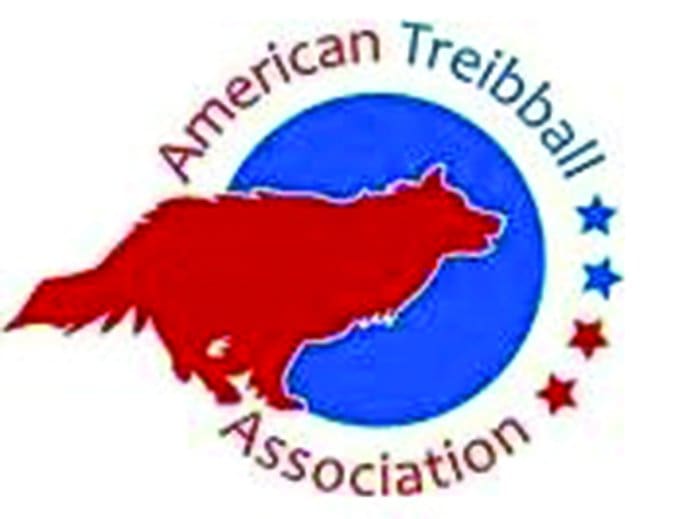
A Different Goal
Critics of video-based titles often say it’s “too easy” to earn a title in the comfort of your own home, specifically because it doesn’t require the same level of generalization or the ability to withstand the various pressures associated with performing successfully at an in-person event. While training to the standard typically required to attain success at in-person events is different from training behaviors that stand up in the privacy of one’s backyard, one goal need not be considered better than the other – they’re just different.
And, just because remote sport runs are videoed in the comfort of your own home or local training center doesn’t mean it’s a cake walk. Organizations that offer video titles for sports that require a sequence of behaviors (such as obedience, agility, rally, and freestyle) generally require video submissions to show the behaviors as a continuous sequence; most disallow editing that stitches together the best attempts from multiple tries.
Also, in agility, rules often stipulate that markers must show proper ring size and contact zones must be clearly visible. Many exhibitors say it can be difficult to find the best camera angles to appropriately demonstrate each required element; this technical challenge may be beyond the ability of some participants. And just because handlers are often working alone, doesn’t mean they don’t get nervous during performances. Just hitting the record button on the camera often introduces ring nerves!
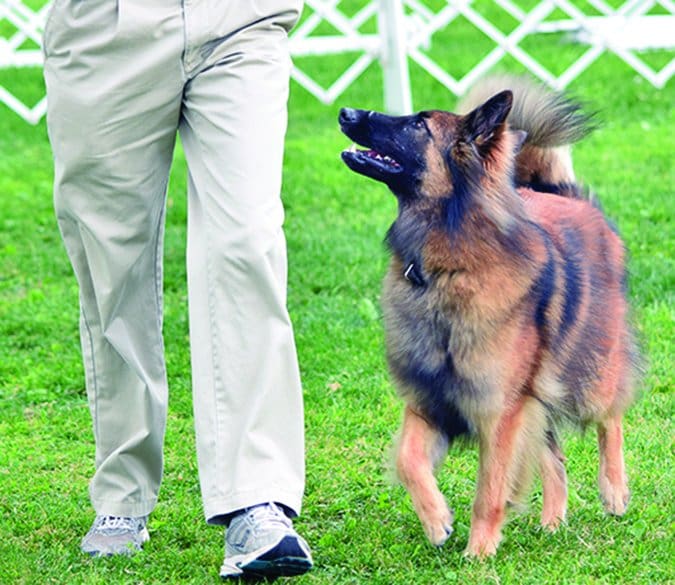
“There’s a lot to be said for showing up to a trial where someone else has set up the ring, you do your one run and you go home, for better or for worse,” says Azaren. “With video trials, there’s added pressure. Often, you’ve rented training space for an hour and you need to set up the course, warm your dog up, and repeat the course however many times until you get every station correct. It’s a lot to do.”
Most people we spoke with support the idea of video-based entries as a way to encourage people to spend time with their dogs.
And that’s what it’s all about, says Azaren, who explains how one’s relationship with a dog often changes once the pair begins to explore dog sports.
“As close as I’ve always been with my pet dogs, when you have a dog who is also your teammate and partner, it’s just a whole new dimension, and it’s so much fun!”
Stephanie Colman is a writer and dog trainer in Los Angeles.


